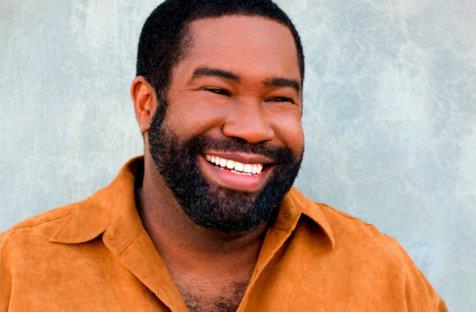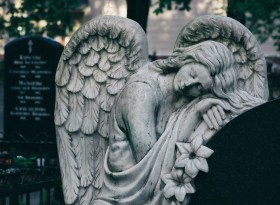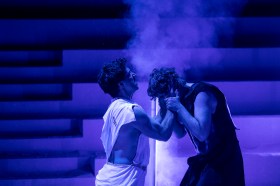Thrilling, is what it was, this latest effort of the Sydney Symphony; a concert performance of Wagner’s opera The Flying Dutchman. Absolutely thrilling. And to be able to tell you this, dear reader, is such a relief, for critics have hearts too (albeit shrivelled and grumbling little organs), and after the Sydney Symphony’s triumph last year with their chief conductor Vladimir Ashkenazy giving us a thrilling (yes, thrilling is the word du jour) rendition of Tchaikovsky’s Queen of Spades, this critic was worried that new chief conductor David Robertson wouldn’t be up to the task. (One had seen him pull out some wonderful performances, but nothing approaching anywhere near the two and a quarter hour length – sans interval – of Wagner’s work.) And, memory being the curious thing it is, such that previous experiences are often inflated in worth when looked back upon after some time has passed – the syndrome of the ‘good old days’ – the odds weren’t in Robertson’s favour. Thankfully, there was the video.
Robertson’s performance, if one were to try and compare it to Ashkenazy’s last year, had the same hallmarks of good opera that one requires – the drama was there, as was the intensity and the quality of singing, and the music never lagged unless it meant to.
It is a comfort to the theatre critic, for instance, that, even in a horrible physical production of a play, the worth of the acting alone can still save it from the dustbin of boredom (although, unfortunately, it is fair to say that the quality of acting often corresponds directly to the quality of a production). And with opera, many a dull night out has been saved by the quality of the music and singing despite the lacklustre production. (One needs only think of some old versions of operas in the Opera Australia repertoire, that get wheeled out and half-polished up for a new airing.)
So when one is presented with a production consisting of nothing, it allows one to focus on the music, and this is precisely what happened with the Queen of Spades. But Robertson has given us something more than that – he has given us a pseudo-production, as it were – and this has made things all the more special.
The Concert Hall of the Sydney Opera House had some projections displayed above the orchestra, you see. Not that the Sydney Symphony is in any way unfamiliar with such audiovisual feats – think of their Fantasia concert earlier this month, or their Lord of the Rings series of films – but these projections in particular were something quite new. For starters, the projection screen wasn’t the usual white rectangle, but instead what appeared to be two canvas sails, tapering in and out along the edges (or, rather, curved), like one might see on a trireme or, indeed, the Flying Dutchman. (It was all very thematic, dear reader.) The larger sail was on the bottom, while a smaller one was centred above it.
Surtitles were displayed at the top of the lower sail in a white font, appearing over the images shown there. (Sometimes, depending on the colour of the image, the surtitles were hard to read, but it wasn’t too much of a problem.) S Katy Tucker was the ‘video and projections designer’ especially commissioned for this series of concerts (and I believe the projections will be used with another symphony later in the year) and she has done a superb job of it.
The best way to describe them, I think, would be to conjure up the image of a James Bond title opening without the women or the guns or the cards. The overture, for instance, was a swirling, seething abstract mess of fiery blood, then a stormy yet impossible sea, then the closed-eye face of the Flying Dutchman – among others – that were cued by the various themes toyed with by Wagner. Throughout the night, as these themes came back to the fore, the projections would shift accordingly. Also, in particular dramatic moments, when a climax has been reached and overcome, the projections would be seemingly timed to the music, as the screen would clear itself of red with a flourish of white, and so on.
The house lights, on occasion – and thankfully only on occasion, for any more would have been a tad kitsch and ridiculous – were used to add a red or blue glow to the ambience, including lighting up the Concert Hall ceiling with some swirling patterns as well, like the reflections of the light from a fountain on a nearby wall at night. Basically, this was as good as an opera without a production can get, production-wise. One hopes to see something like this again next year, and one hopes Robertson has it planned.
As for the opera itself, none of it would have mattered if the singing or the music was without merit, but no one needed worry on that account. Perhaps the weakest performer of the night was tenor John Tessier as the Steersman, but his role was less than large, and so one cared not. (Which is not to say that he was awful by any means, but he was a blip on the radar compared to the other singers.) Baritone Eric Owens was at his booming best as The Dutchman, while Orla Boylan powered her way through the role of Senta – the Dutchman’s marital salvation – with an impressive tone. Bass Ain Anger as Daland and tenor John Daszak as Erik also provided wonderful interpretations of their parts, while mezzo-soprano Sally-Anne Russell as Mary supported nicely.
The Sydney Philharmonia Choirs, situated in the furthest box back on either side – women to the left, men to the right – were in fine form, although it was a tad confusing, given that one had to negotiate the surtitles as well – when the male chorus split into two, even if half of them brought out black cardboard megaphones to help differentiate themselves.
But it was Robertson who was the star here, and if anyone had doubts about how exciting the next few seasons of the Sydney Symphony might be (including this critic, one might add, who was merely optimistic), then this was a good argument for joys to come. To manage to keep one’s attention riveted for two and a quarter hours is a skill that shouldn’t be overlooked, and it has to do with his attention to the smaller parts, as well as his visible enthusiasm for the music. (At one point, for instance, he, to make the orchestra start quietly, crouched down, arms out, until his waist was almost at floor level, and slowly stood up again. The music at that point was quite loud followed by a sudden softness that built upon itself.) Marvellous, magnificent stuff. And of such high quality, too, that this critic is rather confused as to whether he now looks forward to opera with the Sydney Symphony, or opera with Opera Australia. I think the Sydney Symphony has it for the moment.
Rating: 5 stars out of 5
The Flying Dutchman
Sydney Symphony
Conductor: David Robertson
Video & projections designer: S Katy Tucker
With Eric Owens (baritone), Orla Boylan (soprano), Ain Anger (bass), John Daszak (tenor), John Tessier (tenor), Sally-Anne Russell (mezzo-soprano) and the Sydney Philharmonia Choirs
Richard Wagner – Der fliegende Hollander (The Flying Dutchman)
Concert Hall, Sydney Opera House
20 July






